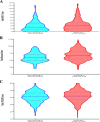Evaluation of psychological distress, burnout and structural empowerment status of healthcare workers during the outbreak of coronavirus disease (COVID-19): a cross-sectional questionnaire-based study
- PMID: 38254016
- PMCID: PMC10804486
- DOI: 10.1186/s12888-023-05088-x
Evaluation of psychological distress, burnout and structural empowerment status of healthcare workers during the outbreak of coronavirus disease (COVID-19): a cross-sectional questionnaire-based study
Abstract
Background: In light of several recent studies, there is evidence that the coronavirus disease 2019 (COVID-19) pandemic has caused various mental health concerns in the general population, as well as among healthcare workers (HCWs). The main aim of this study was to assess the psychological distress, burnout and structural empowerment status of HCWs during the COVID-19 outbreak, and to evaluate its predictors.
Methods: This multi-center, cross-sectional web-based questionnaire survey was conducted on HCWs during the outbreak of COVID-19 from August 2020 to January 2021. HCWs working in hospitals from 48 different countries were invited to participate in an online anonymous survey that investigated sociodemographic data, psychological distress, burnout and structural empowerment (SE) based on Depression Anxiety and Stress Scale 21 (DASS-21), Maslach Burnout Inventory (MBI) and Conditions for work effectiveness questionnaire (CWEQ_II), respectively. Predictors of the total scores of DASS-21, MBI and CWEQ-II were assessed using unadjusted and adjusted binary logistic regression analysis.
Results: Out of the 1030 HCWs enrolled in this survey, all completed the sociodemographic section (response rate 100%) A total of 730 (70.9%) HCWs completed the DASS-21 questionnaire, 852 (82.6%) completed the MBI questionnaire, and 712 (69.1%) completed the CWEQ-II questionnaire. The results indicate that 360 out of 730 responders (49.3%) reported severe or extremely severe levels of stress, anxiety, and depression. Additionally, 422 out of 851 responders (49.6%) reported a high level of burnout, while 268 out of 712 responders (37.6%) reported a high level of structural empowerment based on the DASS-21, MBI, and CWEQ-II scales, respectively. In addition, the analysis showed that HCWs working in the COVID-19 areas experienced significantly higher symptoms of severe stress, anxiety, depression and higher levels of burnout compared to those working in other areas. The results also revealed that direct work with COVID-19 patients, lower work experience, and high workload during the outbreak of COVID-19 increase the risks of negative psychological consequences.
Conclusion: Health professionals had high levels of burnout and psychological symptoms during the COVID-19 emergency. Monitoring and timely treatment of these conditions is needed.
Keywords: Anxiety; Burnout; COVID-19; Depression; Predictors; Stress; Structural empowerment.
© 2024. The Author(s).
Conflict of interest statement
The authors declare no competing interests.
Figures




Similar articles
-
The Sustained Psychological Impact of the COVID-19 Pandemic on Health Care Workers One Year after the Outbreak-A Repeated Cross-Sectional Survey in a Tertiary Hospital of North-East Italy.Int J Environ Res Public Health. 2021 Dec 19;18(24):13374. doi: 10.3390/ijerph182413374. Int J Environ Res Public Health. 2021. PMID: 34948981 Free PMC article.
-
Survey of Immediate Psychological Distress Levels Among Healthcare Workers in the COVID-19 Epidemic: A Cross-Sectional Study.Adv Exp Med Biol. 2021;1321:237-243. doi: 10.1007/978-3-030-59261-5_20. Adv Exp Med Biol. 2021. PMID: 33656728
-
Secondary Traumatic Stress and Burnout in Healthcare Workers during COVID-19 Outbreak.Int J Environ Res Public Health. 2021 Jan 5;18(1):337. doi: 10.3390/ijerph18010337. Int J Environ Res Public Health. 2021. PMID: 33466346 Free PMC article.
-
Reported effects of the COVID-19 pandemic on the psychological status of emergency healthcare workers: A scoping review.Australas Emerg Care. 2022 Sep;25(3):197-212. doi: 10.1016/j.auec.2021.10.002. Epub 2021 Nov 12. Australas Emerg Care. 2022. PMID: 34802977 Free PMC article.
-
Prevalence of burnout among healthcare professionals during the COVID-19 pandemic and associated factors - a scoping review.Int J Occup Med Environ Health. 2023 Mar 2;36(1):21-58. doi: 10.13075/ijomeh.1896.02007. Epub 2023 Feb 2. Int J Occup Med Environ Health. 2023. PMID: 36727492 Free PMC article.
References
MeSH terms
Supplementary concepts
LinkOut - more resources
Full Text Sources
Medical

